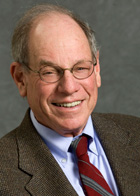
Robert A. Kagan provides his own perspective on major influences and broad themes underpinning his research.
The generous and insightful comments by Professors Barnes, Burke, Coglianese, Epp, and Kelemen have encouraged me to see if I too could identify some themes in my scholarly career. That led me to the following autobiographical reflections.
I graduated from law school in 1962, and spent three and a half years practicing law in Newark, New Jersey – the city where I was born. Then I went to work at my father’s small wire manufacturing business. I had worked in the factory every summer during high school and college. Compared to the commercial litigation I had been doing, I thought that making useful stuff and providing decent jobs would be more socially constructive. But three years later, his business was acquired by a large southern aluminum and cable company. I decided to leave, not sure about what to do next.
Around that time, my uncle, the political scientist Herbert McClosky, sent me a copy of Volume 1, Issue 1 of the Law & Society Review. That introduction to the social scientific study of the law and legal processes stimulated me to apply for a Russell Sage Foundation Law and Social Science fellowship. Stan Wheeler, who headed the program, offered me a fellowship if I would come to Yale and study the sociology of law with him.
In my first semester in graduate school, in 1969, I read Philip Selznick’s just-published Law, Society and Industrial Justice. Socio-legal studies, Selznick wrote, are ideally about “the fate of values in society,” and what frustrates or promotes their achievement. That resonated with me. It is reflected in my subsequent inclination to undertake studies that might help us understand what promotes or undermines “good governance,” as Burke and Barnes put it. Epp is correct, I think, in observing that much of my work reflects that underlying normative motivation – and sometimes, in my books Adversarial Legalism and Going by the Book, a somewhat overtly normative cast.
Also in that first semester of graduate school, I became a research assistant in a study of housing code enforcement in New Haven. I visited low-income apartments with inspectors. I observed how they interacted with landlords, and how they translated the code provisions into working norms. I liked how this anthropological mode of research helped reveal the extent to which law really did and did not matter.
I also liked the idea of studying legal processes in legal institutions other than the courts. I believed (and still believe) that the growth of the activist regulatory and administrative state had been the most ambitious, far-reaching legal development of the 20th century. Yet this elephant in the legal room, it seemed to me, had mostly been neglected by socio-legal scholars. The regulatory state was scholarly terra incognita ripe for empirical exploration – particularly of a kind that generated a granular, inside-the-agency feel for how officials conceived their tasks, the norms and political constraints that guided them, and how regulated entities responded to regulatory demands.
My Ph.D. dissertation research was an opportunistic lurch down that pathway. One evening in August 1971, I saw President Nixon announce a nationwide freeze order on television, forbidding increases in all prices, wages, and rents for 90 days. I soon realized that a completely new body of detailed legal rules would have to be constructed, plus a whole new implementation system. Two days later, I got on a plane to Washington.
Then some serendipity: I had once worked on a lawsuit with a Washington lawyer named Elmer Bennett. Now, lo and behold, Bennett was the General Counsel of the Office of Emergency Preparedness, the very agency charged with day-to-day implementation of the freeze. Bennett needed more lawyers. I volunteered to work in his office in return for the opportunity to study the process. He agreed. I served there for two and a half months, debating and deciding requests for exceptions from the freeze, drafting opinion letters, interacting with the rule-making committee, and much more.
The second half of the dissertation, and my subsequent book, Regulatory Justice (Russell Sage Foundation, 1968), offers an up-close account and analysis of the different ways in which legal officials actually used legal rules in deciding cases. To describe that variation, I developed a typology of modes or styles of rule-application – legalistic as opposed to policy-oriented, consistency-oriented versus ad hoc flexibility – and then discussed when and why one style of rule application or another tends to predominate. For example, at the micro-level, intense organizational pressures for rapid decisionmaking and inadequate factual records were conducive of legalistic decisionmaking. Legalism – rather than responsiveness – was less likely when the official met face to face with a party, or when a regulated entity was able to provide a lot of detailed information about its situation and the adverse consequences of a stringent decision. That analysis is still quite relevant, I think, not only to legal decisionmaking in bureaucracies but also to decisionmaking by judges.
In my subsequent studies, I flitted like a butterfly from one context to another, exploring different niches in the legal ecosystem: debt collection; dock labor regimes in seaports; compliance with anti-smoking ordinances; pollution control in pulp mills and diesel trucking companies; and compliance with income tax law. But most of those studies, I now realize, reflect the same basic motivations and characteristics as my dissertation research. That is, most of my projects, like Regulatory Justice, have been small sample case studies. They are based on field research and interviews with key participants, particularly with the front-line officials who deal directly with the public. I often studied the ruled as well as the rulers, in order to better understand the actual consequences of legal decisions and rules. Like Regulatory Justice, most of my publications provide “thick description” of legal processes and often use short stories and vignettes to give readers a tangible feel for the legal and policy dilemmas involved.
And as in Regulatory Justice, in most of my studies I map variation in institutional arrangements and behavior, using a new conceptual typology. I think those typologies may be the most generally useful product of my work.
Let me mention a few other people who shaped my scholarship. First, I have worked with a wonderful series of collaborators – most significant, in terms of influence: the legal historian Lawrence Friedman, my Berkeley colleague Eugene Bardach, and Neil Gunningham and Dorothy Thornton (who first advanced the “license to operate” concept and the typology of management styles we developed in Shades of Green). I have also profited greatly from collaborations with David Vogel, Jerry Skolnick, Diana Kapiszewski, Gordon Silverstein, Rachel Vansickle-Ward, John T. Scholz, Cary Coglianese, and Lee Axelrad. And just as importantly, I have been very fortunate to have spent my academic career in UC Berkeley’s great and eclectic political science department, and in its Center for the Study of Law & Society, founded and inspired by Philip Selznick.
Second, when I joined the Berkeley political science faculty in 1974, I was incredibly fortunate to have Sandy Muir as an immensely supportive and inspiring senior colleague in our public law group. Sandy and I were both drawn to the detailed study of specific institutions and processes, and to showing how they can be analyzed as microcosms that illuminate larger theoretical issues. For instance, Sandy’s conception of the “good police officer,” built from his detailed study of the education of 30 rookie cops, was the inspiration for the portrait of “the good inspector’ that Bardach and I paint in Going by the Book.
Third, in 1987, Erhard Blankenburg, a legal sociologist from Amsterdam, got me invited to the Netherlands Institute of Advanced Study. Interacting daily with Erhard and other Dutch sociologists of law launched me toward the cross-national comparative work that Dan Kelemen writes of so warmly. My Adversarial Legalism book, for example, emerged from my study of an extended political-legal-environmental controversy over harbor-dredging in the port of Oakland, California. That research was part of a comparative study of how national differences in politics, environmental regulation, and labor law affected seaport operations and development. My effort to understand what happened in the Oakland case study was what led me to concoct a typology of modes of dispute resolution and policy-implementation, including the concept of adversarial legalism.
Yet unlike much of my other work, which clearly bears the imprint of my background in sociology, Adversarial Legalism is also – and perhaps most importantly – a political science book. It is about how politics shapes legal institutions and processes. All my years of working and teaching in a political science department, learning from colleagues and graduate students, had finally made a difference.
Most of my projects, including Adversarial Legalism, have basically been exploratory ventures into new empirical and theoretical territory. Hence they rarely test theories or hypotheses drawn from prior studies; the findings, concepts, and explanatory propositions are far from definitive. Nowadays, political science seems less tolerant of that kind of exploratory, descriptively rich, qualitative, small-N research. I think it is worth remembering, however, that close observation, description, and theoretical conjecture are crucial first steps in the development of scientific theories. Before he could formulate his theory of natural selection, Darwin first took a long voyage on The Beagle, sketching variation in the beaks of finches and ecosystems.
I hope there will still be a place for exploratory research. That hope is greatly bolstered by the extraordinarily kind essays by Professors Barnes, Burke, Coglianese, Epp, and Kelemen – as well as by the decision of the Law and Courts Section of the American Political Science Association to give me a great honor.
This essay is part of a five-part series, Honoring Robert A. Kagan.




